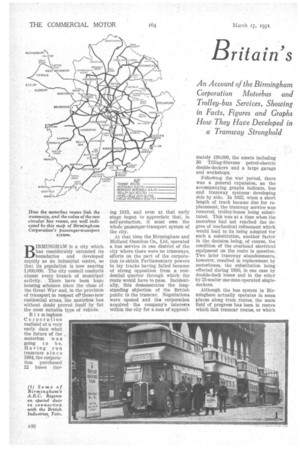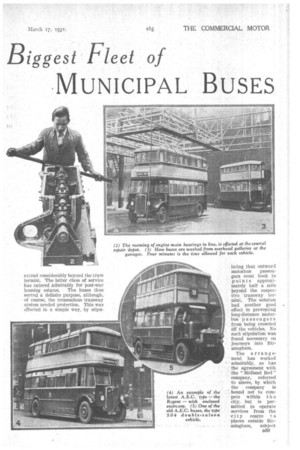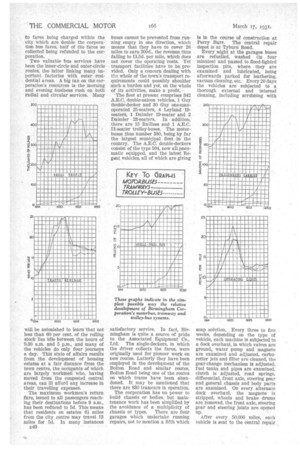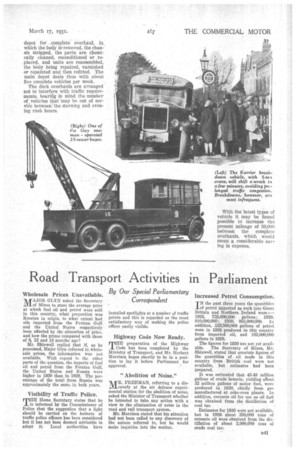Britain's
Page 108

Page 109

Page 110

Page 111

If you've noticed an error in this article please click here to report it so we can fix it.
Biggest Fleet of
MUNICIPAL BUSES
BIRMINGHAM is a city which has considerably extended its boundaries and developed rapidly as an industrial centre, so that its population is now nearing 1,000,000. The city council conducts almost every branch of municipal activity. There have been huge housing schemes since the close of the Great War and, in the provision of transport in respect of' these. new residential areas, the motorbus has without doubt proved itself by far the most suitable type of vehicle.
Birm ingham Corporation realized at a very early date what the future of the ,. motorbus w a s going to b e. Having run tramcars since 1904, the corporation purchased 12 buses dur ing 1913, and even at that early stage began to appreciate that, in self-protection, it must own the whole passenger-transport system of the city.
At that time the Birmingham and Midland Omnibus Co., Ltd, operated a bus service in one district of the city where there were no tramways, efforts on the part of the corporation to obtain Parliamentary powers to lay tracks having failed because of strong opposition from a residential quarter through which the route would have to pass. Incidentally, this demonstrates the longstanding objection of the British public to the tramcar. .Negotiations were opened and the corporation acquired the company!s interests within the city for a sum of approxi rnately 130,000, the assets including 30 Tilling-Stevens petrol-electric double-deckers and a large garage and workshops.
Following the war period, there was a general expansion, as the accompanying graphs indicate, bus and tramway systems' developing side by side. In 1922, when a short length of track became due for replacement, the tramway service was removed, trolley-buses being substituted. This was at a time when the motorbus had not reached the degree of mechanical refinement which would lead to its being adopted for such a substitution, another factor in the decision being, of course, the condition of the overhead electrical equipment on the route in question. Two later tramway abandonments, however, resulted in replacement by motorbuses, the substitution being effected during 1930, in one case by double-deck buses and in the other by 25-seater one-man-operated singledeckers.
Although the bus system in Birmingham actually operates in some places along tram routes, the main field of progress has been in routes which link tramcar routes, or which extend considerably beyond the tram termini. The latter class of service has catered admirably for post-war housing estates. The buses thus served a definite purpose, although, of course, the tremendous tramway system needed protection. This was effected in a simple way, by stipu latiog that outward motorbus passengers must book to points approximately half a mile beyond the respective tramway termini. The solution had another good . effect in preventing long-distance motorbus passengers from being crowded Off the vehicles. No such stipulation was found necessary on journeys into Bir mingham.
The arra ng e
• inent. has worked admirably, as has the agreement with the " Midland Red" company, referred to above, by which the company is
• hound not to compete within t h e city, but is permitted to operate • services from the city centre t places outside Birmingham, subject to fares being charged within the city which are double the corporation bus fares, half of the fares so collected being refunded to the corporation.
Two valuable bus services have been the inner-circle and outer-circle routes, the latter linking many important factories with outer residential areas. A big tax on the corporation's resources is the morning and evening business rush on both radial and circular services. Many will be astonished to learn that not less than 60 per cent, of the rolling stock lies idle between the hours of 9.30 a.m. and 5 p.m., and many of the vehicles do only four journeys a day. This state of affairs results from the development of housing estates at a fair distance from the town centre, the occupants of which are largely workmen who, having moved from the congested central areas, can ill afford any increase in their travelling expenses.
The maximum workmen's return fare, issued to all passengers reaching their destinations before 9 a.m., has been reduced to 5d. This means that residents on estates 6i miles from the city centre may travel 13 miles for 5d. In many instances n40 buses cannot be prevented from running empty in one direction, which means that they have to cover 26 miles to earn 300d., the revenue thus falling to 11.5d. per mile, which does not cover the operating 'costs. Yet transport facilities have to be provided. Only a concern dealing with the whole of the town's transport requirements could possibly shoulder such a burden and yet, on the whole of its activities, make a profit.
The fleet at present comprises 342 A.E.C. double-saloon vehicles, 1 Guy double-decker and 30 Guy one-manoperated 25-seaters, 4 Leyland 19seaters, 1 Daimler 19-seater and 2 Daimler 23-seaters, In addition, there are 15 Railless and 1 A.E.C. 51-seater trolley-buses. The motorbuses thus number 380, being by far the largest munieipal fleet in the country. The A.E.C: double-deckers consist of the type 504, now all pneumatic equipped, and the latest Regent vehicles, all of which are giving satisfactory service. In fact, Birmingham is quite a source of pride to the Associated Equipment Co., Ltd. The single-deckers, in which the driver collects the fares, were originally used for pioneer work on new routes. Latterly they have been employed in the development of the Bolton Road and similar routes, Bolton Road being one of the routes on which trams have been abandoned. It may be mentioned that there are 830 tramcars in operation.
The corporation has no power to build chassis or bodies, but maintenance work has been simplified by the avoidance of a multiplicity of chassis or types. There are four garages which undertake running repairs, not to mention a fifth which Is in the course of construction at Perry Barr. The central repair depot is at Tyburn Road.
Every night at the garages buses are refuelled, washed (in four minutes) and passed to flood-lighted inspection pits, where they are examined and lubricated, being afterwards parked for leathering, vacuum cleaning, etc. Every 20 days the vehicles are subjected to a thorough external and internal cleaning, including scrubbing with soap solution. Every three to five weeks, depending on the type of vehicle, each machine is subjected to a dock overhaul, in which valves are ground, water pump and magneto are examined and adjusted, carburetter jets and filter are cleaned, the gear-change mechanism is adjusted, fuel tanks and pipes are examined, clutch is adjusted, road springs, differential, front axle, steering gear and general chassis and body parts are examined. On every alternate dock overhaul, the magneto is stripped, wheels and brake drums are removed, the front axle, steering gear and steering joints are opened up.
After every 50,000 mileS, each vehicle is sent to the central repair depot for complete overhaul, in, which the body is'removed, the chassis stripped, the parts are chemically cleaned, reconditioned or replaced, and units are reassembled, the bOdy being repaired, varnished or repainted and then refitted. The main depot deals thus with about five complete vehicles per week.
The dock overhauls are arranged not to interfere with traffic requirements, kering in mind the number of vehicles that 'may be out of serviCe betrween`the Morning and evening rush hours.
























































































































































































